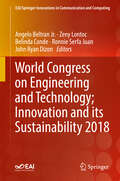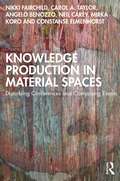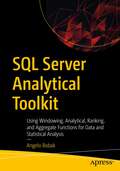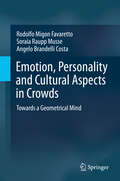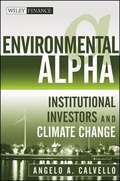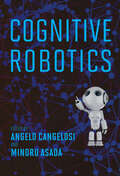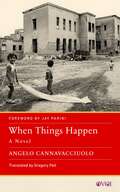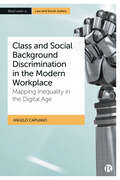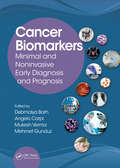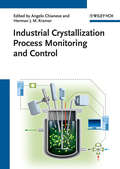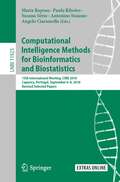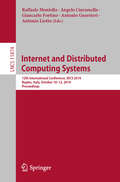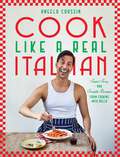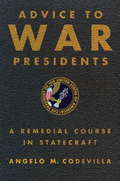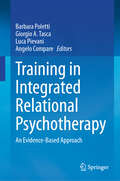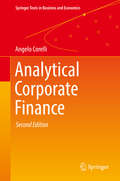- Table View
- List View
World Congress on Engineering and Technology; Innovation and its Sustainability 2018 (EAI/Springer Innovations in Communication and Computing)
by Angelo Beltran Jr. Zeny Lontoc Belinda Conde Ronnie Serfa Juan John Ryan DizonThe book presents the proceedings of the World Congress on Engineering and Technology, Innovation and its Sustainability (WCETIS 2018), which took place on November 28-29, 2018 in Manila, Philippines. The conference featured the following tracks: Industrial Engineering and Healthcare, Sustainable Infrastructure; Water Resources Planning and Management; Heat transfer and fluids; Electronics and Electrical Engineering; and Internet of Things. Papers stem from academia and industry throughout the world, showing a variety of perspectives.Presents the proceedings of the World Congress on Engineering and Technology, Innovation and its Sustainability (WCETIS 2018), November 28-29, 2018 in Manila, PhilippinesShows how engineering and technology serve to support a variety for industries from manufacturing to water resourcesFeatures papers from a variety of researchers and developers from around the world
Knowledge Production in Material Spaces: Disturbing Conferences and Composing Events
by Neil Carey Carol A. Taylor Nikki Fairchild Angelo Benozzo Mirka Koro Constanse ElmenhorstKnowledge Production in Material Spaces is a curation of the interventions that the authors undertook at a range of academic conferences since 2016. It problematizes disciplined practices and expectations governing academic conference spaces and generates new ways of thinking and doing conferences otherwise. The authors use posthuman, feminist materialist and post-qualitative theories to disrupt knowledge production in neoliberal and bureaucratic conferences spaces. The analysis they offer, and the rhizomatic writing and presentational styles they use, promote a form of educational activism through theory. They interrogate the conference space as a regulated, normalized and standardized mode of academic knowledge production – which they call the ‘AcademicConferenceMachine’ – and playfully subvert the dominant meanings and modes of conferences and workshops to show how we can better interact and produce research, with and for each other. The authors indicate how creative conference practices promote playful possibilities to imagine and produce knowledge differently. This book will appeal to audiences ranging from established professionals to early career scholars, doctoral and master’s students in Education and the social sciences.
SQL Server Analytical Toolkit: Using Windowing, Analytical, Ranking, and Aggregate Functions for Data and Statistical Analysis
by Angelo BobakLearn window function foundational concepts through a cookbook-style approach, beginning with an introduction to the OVER() clause, its various configurations in terms of how partitions and window frames are created, and how data is sorted in the partition so that the window function can operate on the partition data sets. You will build a toolkit based not only on the window functions but also on the performance tuning tools, use of Microsoft Excel to graph results, and future tools you can learn such as PowerBI, SSIS, and SSAS to enhance your data architecture skills.This book goes beyond just showing how each function works. It presents four unique use-case scenarios (sales, financial, engineering, and inventory control) related to statistical analysis, data analysis, and BI. Each section is covered in three chapters, one chapter for each of the window aggregate, ranking, and analytical function categories.Each chapter includes several TSQL code examples and is re-enforced with graphic output plus Microsoft Excel graphs created from the query output. SQL Server estimated query plans are generated and described so you can see how SQL Server processes the query. These together with IO, TIME, and PROFILE statistics are used to performance tune the query. You will know how to use indexes and when not to use indexes.You will learn how to use techniques such as creating report tables, memory enhanced tables, and creating clustered indexes to enhance performance. And you will wrap up your learning with suggested steps related to business intelligence and its relevance to other Microsoft Tools such as Power BI and Analysis Services.All code examples, including code to create and load each of the databases, are available online.What You Will LearnUse SQL Server window functions in the context of statistical and data analysisRe-purpose code so it can be modified for your unique applicationsStudy use-case scenarios that span four critical industriesGet started with statistical data analysis and data mining using TSQL queries to dive deep into dataStudy discussions on statistics, how to use SSMS, SSAS, performance tuning, and TSQL queries using the OVER() clause.Follow prescriptive guidance on good coding standards to improve code legibility Who This Book Is ForIntermediate to advanced SQL Server developers and data architects. Technical and savvy business analysts who need to apply sophisticated data analysis for their business users and clients will also benefit. This book offers critical tools and analysis techniques they can apply to their daily job in the disciplines of data mining, data engineering, and business intelligence.
Technology Dynamics: The Generation of Innovative Ideas and Their Transformation Into New Technologies
by Angelo BonomiWhile science and technology research, sources of funding, performance, incentives, and motivations for technology innovation activities are reasonably well understood by academics and policy makers, the complex process by which scientific results are exploited and transformed into new technologies through an innovation process is poorly documented and studied little. Technology Dynamics is dedicated to the complex activity of technology innovation, with the aim of describing how innovative ideas are generated and their transformation into new technologies. It is based on the idea that technology evolves continuously with time, is changed by innovations, and is characterized by a dynamic that is constituted by technological processes occurring in organizational structures, as well as during the use of technologies. The five chapters Discuss technological processes for innovation; Describe innovation within organizational structures; Offer information on interfacing of science and economic factors with technology; Suggest new statistical studies for innovation and new approaches for innovation policies; and Examine the contribution of technology dynamics to statistical studies and promotion of technology innovation. This book is aimed at managers developing strategies for technology innovation, researchers interested in exploiting scientific results for innovative ideas and new technologies, scholars and students studying the economics of innovation. The book would also of interest to private or public financiers of innovation and policy makers involved in economic growth strategy.
Technology Innovation: Models, Dynamics, and Processes
by Angelo BonomiTechnology Innovation discusses the fundamental aspects of processes and structures of technology innovation. It offers a new perspective concerning fundamentals aspects not directly involved in the complex relations existing between technology and the socio-economic system. By considering technology and its innovation from a scientific point of view, the book presents a novel definition of technology as a set of physical, chemical and biological phenomena, producing an effect exploitable for human purposes. Expanding on the general model of technology innovation by linking the model of technology, based on a structure of technological operations, with the models of the structures for technology innovation, based on organization of fluxes of knowledge and capitals, the book considers various technological processes and the stages of the innovation process. Explains a novel definition of technology as a set of physical, chemical and biological phenomena producing an effect exploitable for human purposes Discusses technology innovation as result of structures organizing fluxes of knowledge and capitals Provides a technology model simulating the functioning of technology with its optimization Presents a technology innovation model explaining the territorial technology innovation process Offers a perspective on the evolution of technology in the frame of an industrial platform network The book is intended for academics, graduate students and technology developers who are involved in operations management and research, innovation and technology development.
Emotion, Personality and Cultural Aspects in Crowds: Towards a Geometrical Mind
by Rodolfo Migon Favaretto Soraia Raupp Musse Angelo Brandelli CostaThis practically-focused book presents a computational model for detection and analysis of pedestrian features in crowds from video sequences.The study of human behavior is a subject of great scientific interest and probably an inexhaustible source of research. The analysis of pedestrians and groups in crowds is relevant in several areas of application, such as security, entertainment, environmental and public spaces planning and social sciences. Cultural and personality aspects are attributes that can influence personal behavior and affect the group in which individuals belong.In this sense, we consider different ways of characterizing individuals and groups in crowds with respect to their relationship with the geometrical space and time. We discuss and describe an approach to extract and analyse, from the Computer Science point of view, emotions, personalities and cultural aspects from crowds and groups of pedestrians, using Computer Vision techniques.Extracting characteristics from real pedestrians and crowds, benefits other areas, such as: architecture and design (planning spaces to maximize pedestrian and group-environment fit); security and surveillance (design of evacuation plans considering characteristics of the crowds and detection of abnormal events); entertainment (more realistic crowds in movies and games reproducing characteristics from real pedestrians and crowds); social sciences (understanding of human behavior), among others.A big challenge in this area of research is the comparison with real life data. In this book, we successfully compared the results of the proposed approach with Psychology literature, where several studies aimed to analysis human behavior.
Environmental Alpha
by Angelo CalvelloThe definitive guide to how institutional investors should approach the risks and opportunities associated with climate changeEnvironmental Alpha provides institutional investors with the comprehensive framework they need to assess the risks and investment opportunities tied to climate change.Climate change will present institutional investors with some of the most important risks and opportunities they will face for generations to come. Climate change has the potential to affect many sectors in radically different degrees over time, and institutional investors need to have a thorough understanding of the multi-dimensional risks and opportunities that could influence nearly every investment in their portfolios. This volume is composed of contributions by leading experts in environmental investment, moving beyond the theoretical or academic nature of much of the current discussion on the topic to provide you with real-world insights into an emerging market.Examines the climate change-related drivers of returns (science, economics, policy, and technology) that make environmental alpha possibleExplores fiduciary duty and climate changeContains in-depth explanations of each of the major categories of environmental investing and examines related environmental alpha opportunitiesDiscusses practical implementation issuesPresents real-world case studies and examplesClimate change will be one of the most important investment themes of the next twenty years; the related environmental investment opportunities will provide institutional investors with some of the greatest "alpha" opportunities for years to come. This book will put you in a better position to assess and access these opportunities.
World Atlas of Submarine Gas Hydrates in Continental Margins
by Christian Berndt Jürgen Mienert Anne M. Tréhu Angelo Camerlenghi Char-Shine LiuThis world atlas presents a comprehensive overview of the gas-hydrate systems of our planet with contributions from esteemed international researchers from academia, governmental institutions and hydrocarbon industries. The book illustrates, describes and discusses gas hydrate systems, their geophysical evidence and their future prospects for climate change and continental margin geohazards from passive to active margins. This includes passive volcanic to non-volcanic margins including glaciated and non-glaciated margins from high to low latitudes. Shallow submarine gas hydrates allow a glimpse into the past from the Last Glacial Maximum (LGM) to modern environmental conditions to predict potential changes in future stability conditions while deep submarine gas hydrates remained more stable. This demonstrates their potential for rapid reactions for some gas hydrate provinces to a warming world, as well as helping to identify future prospects for environmental research. Three-dimensional and high-resolution seismic imaging technologies provide new insights into fluid flow systems in continental margins, enabling the identification of gas and gas escape routes to the seabed within gas hydrate environments, where seabed habitats may flourish. The volume contains a method section detailing the seismic imaging and logging while drilling techniques used to characterize gas hydrates and related dynamic processes in the sub seabed.This book is unique, as it goes well beyond the geophysical monograph series of natural gas hydrates and textbooks on marine geophysics. It also emphasizes the potential for gas hydrate research across a variety of disciplines.Observations of bottom simulating reflectors (BSRs) in 2D and 3D seismic reflection data combined with velocity analysis, electromagnetic investigations and gas-hydrate stability zone (GHSZ) modelling, provide the necessary insights for academic interests and hydrocarbon industries to understand the potential extent and volume of gas hydrates in a wide range of tectonic settings of continental margins. Gas hydrates control the largest and most dynamic reservoir of global carbon. Especially 4D, 3D seismic but also 2D seismic data provide compelling sub-seabed images of their dynamical behavior. Sub-seabed imaging techniques increase our understanding of the controlling mechanisms for the distribution and migration of gas before it enters the gas-hydrate stability zone. As methane hydrate stability depends mainly on pressure, temperature, gas composition and pore water chemistry, gas hydrates are usually found in ocean margin settings where water depth is more than 300 m and gas migrates upward from deeper geological formations. This highly dynamic environment may precondition the stability of continental slopes as evidenced by geohazards and gas expelled from the sea floor. This book provides new insights into variations in the character and existence of gas hydrates and BSRs in various geological environments, as well as their dynamics. The potentially dynamic behavior of this natural carbon system in a warming world, its current and future impacts on a variety of Earth environments can now be adequately evaluated by using the information provided in the world atlas. This book is relevant for students, researchers, governmental agencies and oil and gas professionals. Some familiarity with seismic data and some basic understanding of geology and tectonics are recommended.
Cognitive Systems and Information Processing: 7th International Conference, ICCSIP 2022, Fuzhou, China, December 17-18, 2022, Revised Selected Papers (Communications in Computer and Information Science #1787)
by Angelo Cangelosi Huaping Liu Fuchun Sun Bin Fang Jianwei Zhang Yuanlong YuThis book constitutes the refereed proceedings of the 7th International Conference on Cognitive Systems and Information Processing, ICCSIP 2022, held in Fuzhou, China, during November 18–20, 2022.The 47 papers included in this book were carefully reviewed and selected from 121 submissions. They were organized in the following topical sections as follows: Award; Algorithm; Application; Manipulation & Control; Hardware and Vision.
Emergence of Communication and Language
by Angelo Cangelosi Chrystopher L. Nehaniv Caroline LyonThis book brings together work on the emergence of communication and language drawing on diverse disciplines, including linguistics, psychology, neuroscience, anthropology and computer science. Computational simulations of the emergence of phenomena associated with communication and language play a key role in illuminating some of the most significant issues, and the renewed scientific interest in language emergence has benefited greatly from research in Artificial Intelligence and Cognitive Science. Starting with a road map chapter pointing to the ways in which disparate disciplines can inform and stimulate each other, this book examines the role of simulations as a novel way to express theories in science, and their contribution to the development of a new approach to the study of the emergence of communication and language. Worldwide contributors report on the results at the forefront of this interdisciplinary field and deliver state-of-the-art research and essential reading for researchers and graduates.
Cognitive Robotics (Intelligent Robotics and Autonomous Agents series)
by Angelo Cangelosi and Minoru AsadaThe current state of the art in cognitive robotics, covering the challenges of building AI-powered intelligent robots inspired by natural cognitive systems.A novel approach to building AI-powered intelligent robots takes inspiration from the way natural cognitive systems—in humans, animals, and biological systems—develop intelligence by exploiting the full power of interactions between body and brain, the physical and social environment in which they live, and phylogenetic, developmental, and learning dynamics. This volume reports on the current state of the art in cognitive robotics, offering the first comprehensive coverage of building robots inspired by natural cognitive systems. Contributors first provide a systematic definition of cognitive robotics and a history of developments in the field. They describe in detail five main approaches: developmental, neuro, evolutionary, swarm, and soft robotics. They go on to consider methodologies and concepts, treating topics that include commonly used cognitive robotics platforms and robot simulators, biomimetic skin as an example of a hardware-based approach, machine-learning methods, and cognitive architecture. Finally, they cover the behavioral and cognitive capabilities of a variety of models, experiments, and applications, looking at issues that range from intrinsic motivation and perception to robot consciousness. Cognitive Robotics is aimed at an interdisciplinary audience, balancing technical details and examples for the computational reader with theoretical and experimental findings for the empirical scientist.
When Things Happen: A Novel (Other Voices of Italy)
by Angelo CannavacciuoloMichele Campo is living the bourgeois Italian dream. Now a speech pathologist in his forties, he resides in an expensive Naples home with his partner, Costanza, daughter of an upper-class family. Michele’s own family origins, however, are murkier. When he is assigned to work with five-year-old foster child Martina, he grows increasingly engrossed by her case, as his own buried family history slowly claws its way back to the surface. The first novel by acclaimed Italian writer Angelo Cannavacciuolo to be translated into English, When Things Happen tells a powerful and intriguing story of what we lose when we leave our origins behind. It presents a panoramic view of Neapolitan society unlike any in literature, revealing a city of extreme contrasts, with a glamorous center ringed by suburban squalor. Above all, it is a psychologically nuanced portrait of a man struggling to locate what he values in life and the poor vulnerable child who helps him find it.
Class and Social Background Discrimination in the Modern Workplace: Mapping Inequality in the Digital Age
by Angelo CapuanoThis book exposes how inequalities based on class and social background arise from employment practices in the digital age. It considers instances where social media is used in recruitment to infiltrate private lives and hide job advertisements based on locality; where algorithms assess socio-economic data to filter candidates; where human interviewers are replaced by artificial intelligence with design that disadvantages users of classed language; and where already vulnerable groups become victims of digitalisation and remote work. The author examines whether these practices create risks of discrimination based on certain protected attributes, including ‘social origin’ in international labour law and laws in Australia and South Africa, ‘social condition’ and ‘family status’ in laws within Canada, and others. The book proposes essential law reform and improvements to workplace policy.
21 Days in Normandy: Maj. Gen. George Kitching & the 4th Canadian Armoured Division
by Angelo Caravaggio&“Right[s] some of the injustices done to the Canadians&” on their maligned actions during the Invasion of Normandy. &“An absorbing account&” (Firetrench). The Canadian Fourth Armoured Division crossed the Channel in July 1944 to support the invading forces and assist in the Allied attempts to break out of the Normandy beachhead. They were heavily engaged in Operation Totalize and Operation Tractable but have been criticized for their failure to close the &‘Falaise gap&’ and complete the entrapment of withdrawing German forces. Their commander, Major General George Kitching, was relieved of his command after just twenty-one days in action. Angelo Caravaggio reexamines the division&’s performance and particularly that of its leadership. Using new information, he establishes that, despite entering battle for the first time during one of the most challenging phases of Allied operations in August 1944, the 4th Armoured Division, under Kitching&’s leadership, proved resilient and adaptive in overcoming the volatile and unpredictable nature of warfare in Normandy. The combat operations of August 1944 transformed the division into a battle-hardened combat formation that would later distinguish itself through its ability to generate a sustained drive across France out of the chaos and destruction of the Normandy battles. &“The author uses new information to demonstrate the unit did show flexibility and adapted to the battlefield quickly, despite being thrown into battle during one of the Normandy Campaign&’s critical phases. His arguments are detailed and based upon in-depth research, and the book has many detailed maps to help the reader follow the action.&” —Warfare History Network
Autologous Stem Cell Transplantation: Biological and Clinical Results in Malignancies (Acta Haematologic Ser. #Vol. 114, No. 4)
by Angelo CarellaThis textbook integrates basic research and clinical aspects underlying the most recent results in those malignant diseases where progress is most effective.Recent evidence shows that higher doses are better in inducing higher cure rates in hematological neoplasias, although myeloblation related to dose intensity can be a limiting factor. The toxicity can now be controlled with autologous marrow and peripheral blood progenitor cell transplantation, used with or without growth factors. The combination of high dose chemoradiotherapy followed by re-infusion of autologous stem cells constitute a dramatic advance in the treatment of refactory and relapse hematological neoplasias.
Cancer Biomarkers: Minimal and Noninvasive Early Diagnosis and Prognosis
by Mukesh Verma Debmalya Barh Mehmet Gunduz Angelo CarpiGleaning information from more than 100 experts in the field of cancer diagnosis, prognosis, and therapy worldwide, Cancer Biomarkers: Non-Invasive Early Diagnosis and Prognosis determines the significance of clinical validation approaches for several markers. This book examines the use of noninvasive or minimally invasive molecular cancer m
Thyroid Cancer: From Emergent Biotechnologies to Clinical Practice Guidelines
by Jeffrey I. Mechanick Angelo CarpiThe current age of clinical medicine is witnessing biotechnological innovation at an unprecedented pace. As a result, the recently popularized clinical practice guidelines (CPG), as a tool to assist clinical decision-making, have been struggling to keep up. Thyroid Cancer: From Emergent Biotechnology to Clinical Practice Guidelines rides the wave o
Industrial Crystallization Process Monitoring and Control
by Angelo Chianese Herman J. KramerCrystallization is an important technique for separation and purification of substances as well as for product design in chemical, pharmaceutical and biotechnological process industries. This ready reference and handbook draws on research work and industrial practice of a large group of experts in the various areas of industrial crystallization processes, capturing the essence of current trends, the markets, design tools and technologies in this key field. Along the way, it outlines trouble free production, provides laboratory controls, analyses case studies and discusses new challenges.First the instrumentation and techniques used to measure the crystal size distribution, the nucleation and solubility points, and the chemical composition of the solid and liquid phase are outlined. Then the main techniques adopted to control industrial crystallizers, starting from fundamental approaches to the most advanced ones, including the multivariable predictive control are described. An overview of the main crystallizer types is given with details of the main control schemes adopted in industry as well as the more suitable sensors and actuators.
Computational Intelligence Methods for Bioinformatics and Biostatistics: 15th International Meeting, CIBB 2018, Caparica, Portugal, September 6–8, 2018, Revised Selected Papers (Lecture Notes in Computer Science #11925)
by Maria Raposo Paulo Ribeiro Angelo Ciaramella Susana Sério Antonino StaianoThis book constitutes the thoroughly refereed post-conference proceedings of the 15th International Meeting on Computational Intelligence Methods for Bioinformatics and Biostatistics., CIBB 2018, held in Caparica, Portugal, in September 2018. The 32 revised full papers were carefully reviewed and selected from 51 submissions. The papers present current trends at the edge of computer and life sciences, the application of computational intelligence to a system and synthetic biology and the consequent impact on innovative medicine were presented. Theoretical and experimental biologists also presented novel challenges and fostered multidisciplinary collaboration aiming to blend theory and practice, where the founding theories of the techniques used for modelling and analyzing biological systems are investigated and used for practical applications and the supporting technologies.
Internet and Distributed Computing Systems: 12th International Conference, IDCS 2019, Naples, Italy, October 10–12, 2019, Proceedings (Lecture Notes in Computer Science #11874)
by Antonio Guerrieri Giancarlo Fortino Antonio Liotta Raffaele Montella Angelo CiaramellaThis book constitutes the proceedings of the 12th International Conference on Internet and Distributed Systems held in Naples, Italy, in October 2019. The 47 revised full papers presented were carefully reviewed and selected from 145 submissions. This conference desires to look for inspiration in diverse areas (e.g. infrastructure & system design, software development, big data, control theory, artificial intelligence, IoT, self-adaptation, emerging models, paradigms, applications and technologies related to Internet-based distributed systems) to develop new ways to design and manage such complex and adaptive computation resources.
Cook Like a Real Italian: Super Sexy and Simple Recipes from Cooking with Bello
by Angelo CoassinAngelo Coassin, aka Cooking with Bello, is a passionate, Italian home cook whose enthusiasm is undeniable and infectious – try finding a video of his that doesn’t include a moan of ‘mamma mia’ pleasure or his infamous ‘super sexy’ catchphrase. With Cook Like a Real Italian, learn how to create authentic tasting dishes with the same passion and joy as Angelo. Including 70 classic and contemporary Italian recipes, from carbonara, focaccia and tiramisu to pasta roses, pizza muffins and homemade gelato, you’ll soon have a super-sexy repertoire under your belt. Unrestrictive, easy to follow and using readily available ingredients, Angelo’s recipes will give you the confidence to cook great-tasting Italian food at home with chapters including APPETISERS, PRIMI, SECONDI, DESSERTS and COCKTAILS. With an image alongside each recipe, Cook Like a Real Italian promises to be an inspiring, engaging and joyful cookbook that celebrates real Italian home cooking.
Advice to War Presidents: A Remedial Course in Statecraft
by Angelo Codevilla"War presidents” are hardly exceptional in modern American history. To a greater or lesser extent, every president since Wilson has been a War President. Each has committed our country to the pursuit of peace, yet involved us in a seemingly endless series of wars-conflicts that the American foreign policy establishment has generally made worse. The chief reason, argues Angelo Codevilla in Advice to War Presidents, is that America’s leaders have habitually imagined the world as they wished it to be rather than as it is: They acted under the assumptions that war is not a normal tool of statecraft but a curable disease, and that all the world’s peoples wish to live as Americans do. As a result, our leaders have committed America to the grandest of ends while constantly subverting their own goals. Employing many negative examples from the Bush II administration but also ranging widely over the last century, Advice to War Presidents offers a primer on the unchanging principles of foreign policy. Codevilla explains the essentials-focusing on realities such as diplomacy, alliances, war, economic statecraft, intelligence, and prestige, rather than on meaningless phrases like "international community,” "peacekeeping” and "collective security. ” Not a realist, neoconservative, or a liberal internationalist, Codevilla follows an older tradition: that of historians like Thucydides, Herodotus, and Winston Churchill-writers who analyzed international affairs without imposing false categories. Advice to War Presidents is an effort to talk our future presidents down from their rhetorical highs and get them to practice statecraft rather than wishful thinking, lest they give us further violence.
Training in Integrated Relational Psychotherapy: An Evidence-Based Approach
by Angelo Compare Barbara Poletti Giorgio A. Tasca Luca PievaniThis edited book offers an integrative and evidence-based practice approach to training in psychotherapy, examining common factors across different therapeutic models seen through an attachment theory lens. It stresses the opportunities to handle those therapeutic situations in practice that predict patient outcomes. This edited volume will appeal to instructors and students, particularly as an introductory text on psychotherapy practice that emphasizes the fundamentals of therapist interpersonal skills and approaches. Instructors may use the book, its worksheets, and review exercises to help structure a course in psychotherapy. Individual chapters will interest trainers and students in a more advanced course that teaches interpersonally oriented therapies with an attachment theory foundation. Although written specifically for training contexts, the book will also interest practicing clinicians who wish to extend their skill set to include interventions related to those informed by attachment theory.
Analytical Corporate Finance (Springer Texts in Business and Economics)
by Angelo CorelliThis book draws readers' attention to the financial aspects of daily life at a corporation by combining a robust mathematical setting and the explanation and derivation of the most popular models of the firm. Intended for third-year undergraduate students of business finance, quantitative finance, and financial mathematics, as well as first-year postgraduate students, it is based on the twin pillars of theory and analytics, which merge in a way that makes it easy for students to understand the exact meaning of the concepts and their representation and applicability in real-world contexts. Examples are given throughout the chapters in order to clarify the most intricate aspects; where needed, there are appendices at the end of chapters, offering additional mathematical insights into specific topics. Due to the recent growth in knowledge demand in the private sector, practitioners can also profit from the book as a bridge-builder between university and industry. Lastly, the book provides useful information for managers who want to deepen their understanding of risk management and come to recognize what may have been lacking in their own systems.
Analytical Corporate Finance (Springer Texts in Business and Economics)
by Angelo CorelliThis book draws readers’ attention to the financial aspects of daily life at a corporation by combining a robust mathematical setting and the explanation and derivation of the most popular models of the firm. Intended for third-year undergraduate students of business finance, quantitative finance, and financial mathematics, as well as first-year postgraduate students, it is based on the twin pillars of theory and analytics, which merge in a way that makes it easy for students to understand the exact meaning of the concepts and their representation and applicability in real-world contexts. Examples are given throughout the chapters in order to clarify the most intricate aspects; where needed, there are appendices at the end of chapters, offering additional mathematical insights into specific topics. Due to the recent growth in knowledge demand in the private sector, practitioners can also profit from the book as a bridge-builder between university and industry. Lastly, the book provides useful information for managers who want to deepen their understanding of risk management and come to recognize what may have been lacking in their own systems.
